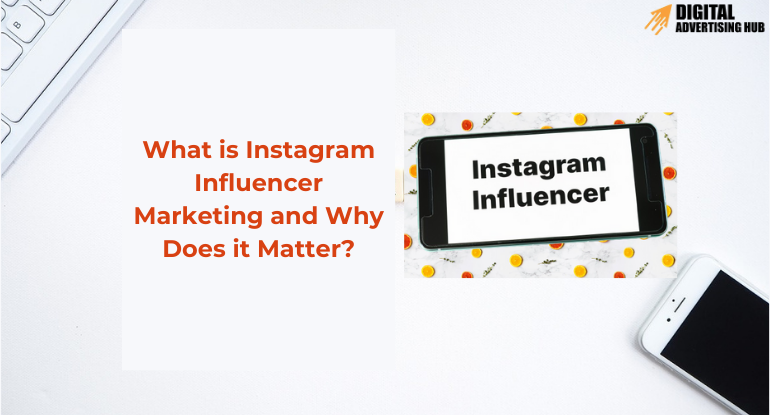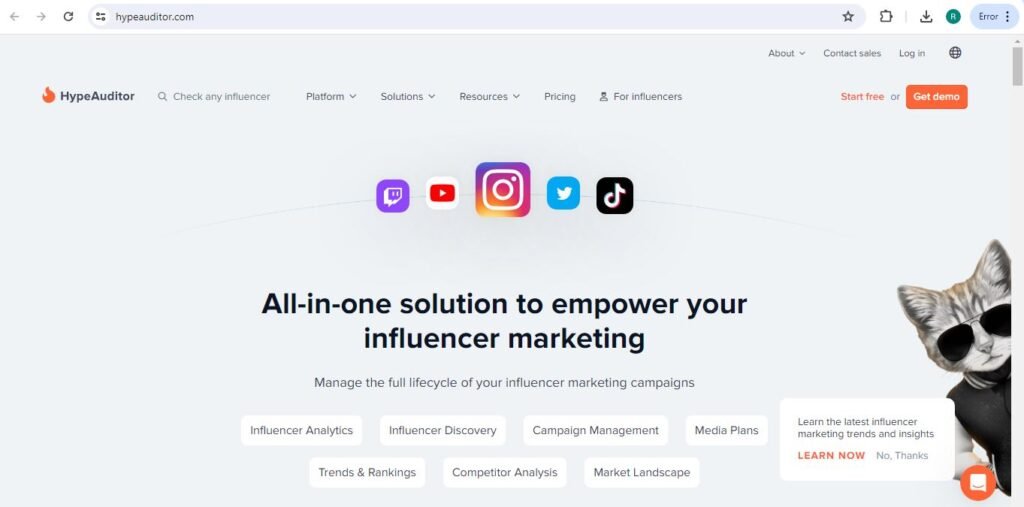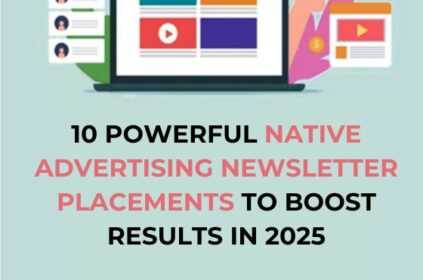Imagine scrolling through Instagram and seeing your favorite influencer raving about a new product. Suddenly, you’re intrigued, right? That’s the power of influencer marketing, and it’s a strategy many brands are using to connect with their target customers.
Instagram influencer marketing has become an effective strategy with nearly 80.8% of marketers planning to leverage its power in 2024 [Hubspot]. This approach harnesses the reach and trust of established personalities on Instagram, enabling brands to connect with their target audience in an authentic and engaging manner.
This guide provides a comprehensive roadmap for navigating the world of Instagram influencer marketing. We’ll explore its benefits, delve into the process of finding the right partners, and equip you with strategies to build successful collaborations. Whether you’re a seasoned marketer or just starting out, this guide will empower you to harness the power of influencer marketing on Instagram and achieve your brand goals.
What is Instagram Influencer Marketing and Why Does it Matter?

Instagram influencer marketing is a strategic marketing technique that leverages the power of social media personalities to promote brands and products. These influencers have established a dedicated following on Instagram and are viewed as experts or trusted figures within their niche.
The effectiveness of this approach hinges on the power of social proof. Consumers are increasingly skeptical of traditional advertising methods. However, when a trusted influencer recommends a product or service, it resonates more authentically with their audience.
This can significantly influence purchasing decisions, as evidenced by statistics like 14% of Gen Z reporting purchases based on influencer recommendations [HubSpot Blog].
In essence, Instagram influencer marketing allows brands to tap into a pre-existing, engaged community that aligns with their target audience. This translates to increased brand awareness, improved brand perception, and ultimately, stronger sales potential.
7 Reasons Why Instagram Influencer Marketing Matters:
#1. Boosts Brand Awareness: Influencers with engaged communities can significantly expand your brand’s reach, introducing your products or services to a wider audience.
#2. Enhances Brand Credibility: Consumers are increasingly skeptical of traditional advertising. Recommendations from a trusted influencer can feel more authentic and trustworthy, driving brand credibility.
#3. Drives Targeted Engagement: The right influencers have cultivated a community aligned with your target audience. Their promotions can spark genuine interest and engagement from potential customers who are already receptive to your brand.
#4. Influences Purchase Decisions: Statistics show that influencer recommendations significantly impact purchasing decisions, especially among younger demographics. Partnering with the right influencers can translate to increased sales.
#5. Generates User-Generated Content: Effective influencer campaigns often inspire user-generated content (UGC) as followers recreate or showcase the influencer’s experience with your brand. UGC fosters a sense of authenticity and encourages further engagement.
#6. Offers Valuable Content Marketing Opportunities: Collaborate with influencers to create high-quality content like product reviews, tutorials, or behind-the-scenes glimpses. This content can be repurposed across your marketing channels, adding variety and value to your brand storytelling.
#7. Provides Measurable Results: Unlike traditional marketing channels, influencer marketing campaigns offer trackable metrics. You can analyze engagement, website traffic, and conversion rates to gauge the effectiveness of your partnerships and optimize future campaigns.
By harnessing these advantages of Instagram influencer marketing, you can connect with your target audience in a more authentic and impactful way, ultimately achieving your brand goals.
Setting the Stage for Success: Define Your Goals & Audience
Before diving headfirst into the world of Instagram influencers, it’s crucial to establish a clear roadmap for your campaign. This starts with defining your specific goals. Are you aiming to:
- Increase brand awareness and reach a wider audience?
- Drive website traffic and boost online engagement?
- Generate leads and conversions through influencer promotions?
Having a well-defined objective allows you to tailor your influencer marketing strategy and select partners who best align with those goals.
Equally important is understanding your target audience. Who are you trying to reach with your campaign? Developing a detailed audience profile that considers demographics, interests, and online behavior helps you identify influencers whose followers closely resemble your ideal customer.
By taking the time to define your goals and understand your target audience, you set the stage for a successful and impactful influencer marketing campaign on Instagram.
Finding the Right Influencers: Look Beyond Follower Count
In the realm of Instagram influencer marketing, there’s a common misconception: bigger is always better. While a large follower count might seem impressive, it’s not the sole indicator of a successful influencer partnership. Here’s why:
#1. Engagement matters more: A high follower count doesn’t necessarily translate to genuine engagement. Focus on influencers with a strong engagement rate (likes, comments, shares relative to follower count). This signifies a more active and receptive audience.
#2. Niche relevance is key: Seek out influencers who resonate with your brand’s niche and target audience. A fashion influencer with millions of followers might not be ideal if your brand sells camping gear. Focus on quality over quantity and find influencers whose content aligns with your industry and resonates with your ideal customer.
#3. Brand alignment is crucial: Partner with influencers who embody the values and personality of your brand. Look for individuals who consistently create content that reflects your brand voice and resonates with your target audience.
Finding the right influencers takes effort, but the rewards are substantial.
Effective Strategies to Help You Identify the Perfect Partners
Here are some effective strategies to help you identify the perfect partners:
#1. Social listening: Monitor brand mentions and relevant hashtags to discover influencers already generating buzz around your niche.
#2. Audience analysis: See who your target audience follows and engages with on Instagram. These individuals might be potential influencer partners.
#3. Influencer marketing platforms: Consider utilizing platforms that allow you to search for influencers based on demographics, niche, and engagement metrics.
By prioritizing engagement, niche relevance, and brand alignment, you can move beyond follower count and discover influencers who will genuinely connect with your target audience and drive positive results for your brand.
Audience Analysis and Influencer Marketing Platforms
Mastering Audience Analysis:
Unearthing the right influencers hinges on a deep understanding of your target audience. Here’s how to refine your audience analysis for an impactful influencer marketing campaign:
#1. Leverage Social Listening Tools: Services like Brandwatch and Sprout Social allow you to track brand mentions and relevant hashtags. This reveals which influencers are already generating conversations within your niche, potentially sparking valuable partnerships.
#2. Analyze Audience Demographics: Tools like Facebook Audience Insights (even if you’re not advertising on Facebook) offer valuable demographic data about your existing follower base. Analyze age, location, interests, and online behavior to understand your audience’s online habits and identify influencers who cater to similar demographics.
#3. Dive into Engagement Metrics: Don’t just track follower count; delve into engagement metrics like likes, comments, and shares. Look for influencers whose audience actively interacts with their content, indicating a more engaged and receptive community. Tools like Buzzsumo can help analyze engagement metrics for specific influencers.
Reference Material:
- Sprout Social: Social Listening for Marketers https://sproutsocial.com/features/social-media-listening/
- Hootsuite: How to Use Social Listening for Marketing Success https://www.hootsuite.com/products/insights
- Social Media Today: The Ultimate Guide to Social Media Analytics in 2024 https://www.socialmediatoday.com/
Influencer Marketing Platforms:
While audience analysis lays the groundwork, influencer marketing platforms can expedite your search. Here’s what these platforms offer and some leading options to consider:
#1. Streamlined Influencer Discovery: These platforms utilize sophisticated algorithms to search for influencers based on various criteria like demographics, niche, and engagement metrics. This saves you time and effort in manually searching for potential partners.
#2. Advanced Analytics: Many platforms offer in-depth analytics on influencer performance, including audience demographics, engagement rates, and brand affinity. This data allows you to assess the effectiveness of potential partnerships and identify influencers who best align with your campaign goals.
#3. Campaign Management Tools: Some platforms provide tools to manage your influencer outreach, track campaign performance, and measure results. This simplifies campaign management and streamlines communication with your chosen influencers.
Leading Influencer Marketing Platforms:
#1. HypeAuditor (https://hypeauditor.com/): An all-in-one solution offering influencer discovery, audience analysis, and campaign tracking with AI-powered insights.

#2. Klear (https://www.meltwater.com/en/blog/klear-is-officially-part-of-meltwater): Provides in-depth influencer analytics and audience demographics to help you identify the right partners.
#3. Traackr (https://www.traackr.com/): Offers features like competitor analysis and influencer relationship management tools.
#4. Grin (https://www.grin.com/en/): Focuses on building long-term influencer relationships and provides campaign management functionalities.
While platforms offer valuable tools, they should complement, not replace, your audience analysis efforts.
By combining audience analysis with the capabilities of influencer marketing platforms, you can build a targeted and data-driven approach to influencer selection, maximizing the impact of your Instagram influencer marketing campaigns.
Building Strong Relationships: Crafting Your Pitch & Collaboration
Finding the right influencers is just the first step. Building strong, collaborative relationships is key to a successful campaign. Here’s how to craft a compelling pitch and foster effective collaboration with your chosen influencers:
Crafting Your Pitch:
#1. Personalization is Paramount: Ditch generic templates. Research the influencer, understand their content style, and tailor your message accordingly. Highlight specific aspects of their work that resonate with your brand.
#2. Focus on Value Proposition: Don’t just talk about yourself. Explain how the collaboration benefits the influencer. Will it allow them to connect with a new audience? Offer creative freedom and brand alignment are also important aspects to consider.
#3. Transparency & Clear Expectations: Outline the campaign goals, deliverables (posts, stories, etc.), and compensation structure upfront. Ensure both parties are on the same page to avoid misunderstandings.
Collaboration is Key:
#1. Empowerment with Boundaries: Give influencers creative freedom to express themselves authentically. However, maintain clear brand guidelines to ensure messaging aligns with your brand voice.
#2. Open Communication & Feedback: Maintain regular communication throughout the campaign. Be open to feedback and suggestions from the influencer, while ensuring brand alignment.
#3. Building Long-Term Partnerships: Look beyond single campaigns. Focus on building long-term relationships with influencers who align with your brand values. This fosters trust and can lead to more impactful future collaborations.
By crafting a personalized and value-driven pitch, and fostering open communication throughout the collaboration process, you can build strong relationships with influencers that drive successful campaigns and lasting brand partnerships.
Transparency & Tracking Results: Keeping it Real & Measuring Success
In the world of influencer marketing, transparency is paramount. Here’s why it matters and how to effectively track your campaign’s results:
Transparency Builds Trust:
#1. FTC Regulations: The Federal Trade Commission (FTC) enforces clear disclosure guidelines for influencer marketing. Influencers must disclose sponsored content using terms like #ad or #sponsored. Failing to do so can lead to hefty fines for both brands and influencers.
#2. Building Brand Authenticity: Transparency fosters trust with your audience. When consumers see clear disclosures, they understand the influencer’s relationship with the brand, enhancing the campaign’s authenticity and credibility.
Tracking Your Success:
Defining your KPIs (key performance indicators) upfront allows you to measure campaign effectiveness. These KPIs will vary depending on your goals, but some common metrics to consider include:
#1. Engagement Metrics: Track likes, comments, shares, and saves generated by influencer content. This indicates audience interest and engagement.
#2. Website Traffic & Conversions: Monitor the impact on website traffic and conversions (purchases, sign-ups) driven by influencer promotions. Utilize UTM parameters in your tracking links to attribute traffic sources accurately.
#3. Brand Awareness Metrics: Track reach (number of unique users who saw the content) and impressions (number of times the content was displayed) to gauge campaign reach and brand awareness lift.
Tools for Measurement:

Several free and paid tools can help you track your influencer marketing campaign’s performance:
#1. Instagram Insights: Offers basic engagement data for your branded content and influencer posts.
#2. Google Analytics: Tracks website traffic and conversions driven by influencer campaigns using UTM parameters.
#3. Social Listening Tools: Platforms like Brandwatch and Sprout Social can help monitor brand mentions and sentiment surrounding your campaign.
Tracking results is an ongoing process. Regularly analyze your data to understand what’s working and adapt your approach for future influencer marketing campaigns.
By prioritizing transparency, establishing clear KPIs, and leveraging the right tools, you can effectively measure your influencer marketing campaigns, ensure regulatory compliance, and demonstrate the return on investment (ROI) of your efforts.
Conclusion
Instagram influencer marketing offers a powerful tool to connect with your target audience and achieve your brand goals. By following the steps outlined in this guide, you’ll be well-equipped to navigate the influencer landscape, build strong partnerships, and launch impactful campaigns. Remember, the key lies in:
- Defining your goals and target audience.
- Finding the right influencers – prioritize engagement, niche relevance, and brand alignment over follower count.
- Crafting a compelling pitch and fostering open communication throughout the collaboration.
- Maintaining transparency and adhering to FTC regulations.
- Tracking your results and adapting your strategy based on data.
By implementing these steps, you can harness the power of Instagram influencer marketing and achieve success for your brand.
Ready to take the next step? Read more about Instagram Influencer marketing with our guide.










